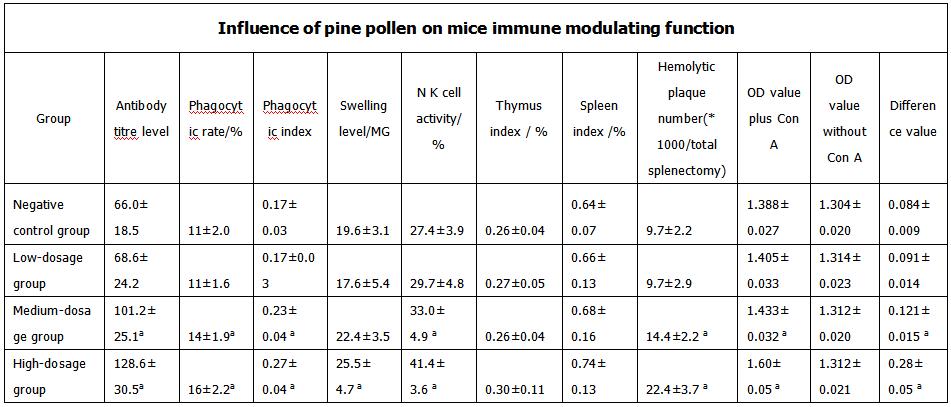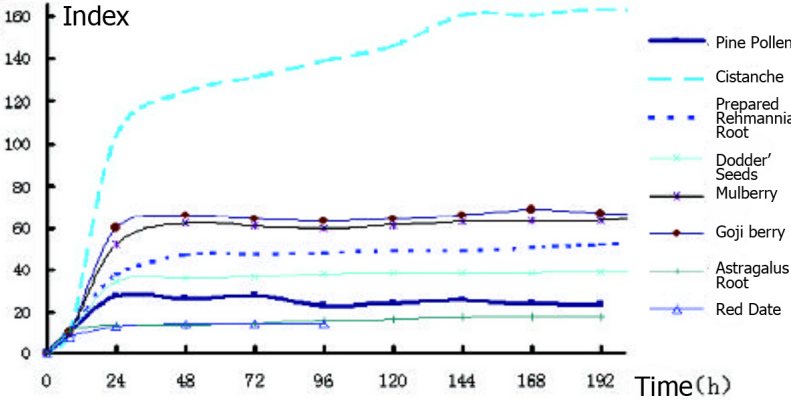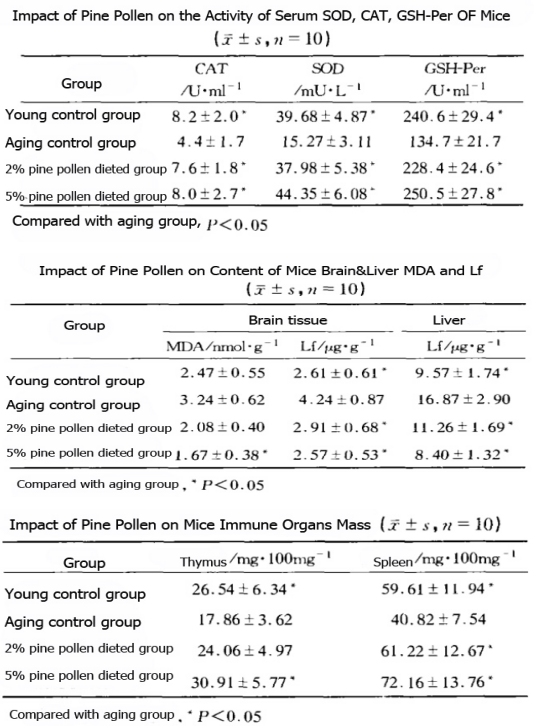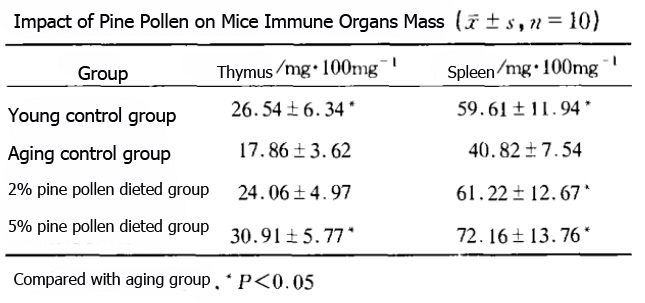The development and utilization of pine pollen in China starts from 1980s and mainly adopt pollen of Pinus Massoniana Lamb., Pinus Tabulaeformis Carr., and Pinus Yunnanensis Franch because these 3 kinds pine tress have the largest distribution in China with thousands years’ history. Below are some researches on different functions of pine pollen in recent years.
Researches on Therapeutic Effect of Pine Pollen on Rats Prostatic Hypertrophy(BPH)(2005,Cong tao, Academic Journal of Chinese People’s Liberation Army Postgraduate)
To study therapeutic effect of pine pollen on rats benign prostatic hypertrophy(BPH) and its mechanism, 24 SD rats were divided into 3 groups. The control group was fed with normal diet. The group 2 and group 3 were fed with 3 starch tablets(as placebo) and 3 pine pollen tablets per day respectively, and the group 2 and group 3 were be pari-fed with group 1. After two weeks, group 2 and group 3 were injected with testosterone propionate(4mg/kg) which was mixed with olive oil. At the same time, group 1 was injected with olive oil(1ml/kg) alone. 2 weeks later, the pathologic slices of prostate were observed, and the sex hormones contents, trace elements zinc, copper and antioxidantive enzymes of serum, prostate and liver were determined. The results showed that the prostate hyperplasia symptoms of pine pollen group are much better than those of placebo group. Testosterone level of group 3 is lower than that of group 2 and no distinct difference from control group. The estradiol level in serum of rats in group 3 is the lowest. Therefore the experiement comes the conclusion that intaking pine pollen could improve the symptoms of BPH and the preventive mechanism can regulate sex hormones balance.
| Prostate Index and Pathological Papillary Hyperplasia Percentage(±s,n=8);Note(a,b)<0.05) | ||||
| Group | Weight(g) | Weight of prostate(mg) | Prostate Index(mg/g) | Papillary Hyperplasia Percentage(%) |
| 1 | 354.5±7.01b | 354.5±7.01b | 2.55±0.20a | 33.3±20.8 |
| 2 | 346.3±10.1b | 346.3±10.1b | 3.26±0.31b | 60.0±10.0b |
| 3 | 334.9±9.65a | 334.9±9.65a | 3.18±0.31b | 20.0±10.0a |
| Blood Biochemical Index And Serum Sex Hormone Levels(±s,n=8);Note(a,b)<0.05) | ||||||
| Group | Blood sugar
(mmol/K) |
Cholesterol
(mmol/L) |
Triglyceride
(mmol/L) |
Urea nitrogen
(mmol/L) |
Testosterone
(nmol/L) |
Estradiol
(pmol/L) |
| 1 | 6.43±2.04b | 1.78a±0.10b | 1.11±0.30b | 9.42±0.97b | 5.30±2.51a | 253.23±40.55b |
| 2 | 4.37±1.50a | 1.67±0.21b | 0.94±0.27b | 6.90±0.56a | 11.85±8.25b | 218.56±50.45 |
| 3 | 4.07±1.38a | 1.49±0.17a | 0.61±0.10a | 7.44±0.79a | 8.85±2.69 | 199.12±37.09a |
At present, the index to measure the degree of BPH(Benign Prostatic Hyperplasia) is via prostate index and pathological section result. The above results shows that prostate weight, prostate index and prostate cell proliferation of pine pollen group rats are distinctly lower than placebo group rats which can clearly prove pine pollen has preventive and therapeutic effect on BPH(Benign Prostatic Hyperplasia). Generally recognized 3 biochemical mechanism that trigger BPH are from 3 ways as male sex hormone, estrogen hormone and growth factor. Above experiment result shows that the serum testosterone content of BPH rats increase greatly which is because of the testosterone propionate injection. Testosterone level of pine pollen group rats is obviously lower than placebo group rats and the serum estrogen level is also lower than rest 2 groups. These differences show that pine pollen not only can effectively control rats serumtestosterone level but also can adjust the serum estrogen level. Above 2 ways can retract the hyperplastic prostate and own a better treating effect without side effects. And application of this plant male andro gamete(pine pollen) in treatment of sex organ diseases is also in conformity with the therapeutic principle of Traditional Chinese Medicine.
In addition, In vitro proliferation experiment is conducted on different sources of cells with pine pollen; the result shows that cells from prostate can be inhibited by pine pollen while the non-prostate sources cells are not. This means pine pollen has a selective inhibitory effect on prostatic cell proliferation, and has a better inhibitory effect on hormone insensitive cells than hormone-dependent cells. Meanwhile, biochemical analysis showed that level of blood urea nitrogen and blood sugar of prostatic hyperplasia rats are lower than control group, creatinine level only showing a decreaing trend; which means the liver function of prostatic hyperplasia rats was affected at a certain degree thus adjusting function decreased. Weight, serum cholesterol, and triglyceride of pine pollen group rats have a distinct decrease. In conclusion, pine pollen not only can adjust the level of male and female hermone, play a therapeutic effect on BPH(Benign Prostatic Hyperplasia) but also can selectively inhibit the cells via a non-hormonal way; therefore it has a positive clinical meaning for medium-elderly men to take pine pollen in a long-term at a certain amount.
Influence On Immune Modulating Function(Chinese Journal of Hospital Pharmacy, 2006(5): 638-639)
2 researchers(Zhang Tun, Jianping Zhu) have conducted an observation research on influence of pine pollen on immune modulating function in mice.
Method: Random group the mice into negative control group(purified water), low-dosage, medium-dosage and high-dosage groups, and feed the each group 0.25g, 0.5g and 1.5g/kg(body weight) with cell-broken pine pollen powder which is equivalent to 5 times, 10 times and 30 times of human clinical dosage. 30 days later serum hemolysin measurement, mice peritoneal macrophages phagocytosis ability test on chicken erythrocyte, dinitrofluorobenzene-induced delayed type hypersensitivity test (DTH), NK cell activity test, mice antibody formation(Hemolytic plaque number), thymus index and spleen index test are conducted, the results are as:
 The Antibody titre level, Phagocytic rate, Phagocytic index, Swelling level, Hemolytic plaque number, N K cell activity and the left and mice right ear difference value of dinitrofluorobenzene-induced delayed type hypersensitivity has significant increase for medium-dosage and high-dosage group compared with negative control group; while Thymus index and Spleen index shows no great change.
The Antibody titre level, Phagocytic rate, Phagocytic index, Swelling level, Hemolytic plaque number, N K cell activity and the left and mice right ear difference value of dinitrofluorobenzene-induced delayed type hypersensitivity has significant increase for medium-dosage and high-dosage group compared with negative control group; while Thymus index and Spleen index shows no great change.
The above experiement shows that cell cracked pine pollen can greatly increase the cellular immune function and cytophagy function, and this change may caused by the nutrition contained in pine pollen.
Researches on Oxidation resistance of Pine Pollen(Agricultural engineering technology: the agricultural product processing industry in 2008; Yutian Liu, Yantai University)
Yutian Liu from Yantai University China has conducted a series of researches on oxidation resistance of pine pollen. The method he adopted is to rank the level of antioxidant substance content of different Antioxidant food by measuring the potassium permanganate index value. The result shows that although the antioxidant substance of pine pollen, astragalus root, dodder’ seeds, red date is less, but their power to eliminate the hydroxyl free radical is strong. And the experiment comes out the conclusion that antioxidant substance in pine pollen has a synergistic effect to eliminate the hydroxyl free radical of pine pollen-dominant complex. This conclusion provided the basis for further researches on pine pollen antioxidant application in food industry.
The K Mn O4 Index Value Change of Antioxidant Food in the Process of Extraction

| The Capacity to Eliminate the Free Radical of Different Antioxidant Food in the Extraction Porcess | ||||||||
| Capacity | Pine Pollen | Cistanche | Prepared Rehmannia Root | Dodder’Seeds | Mulberry | Goji Berry | Astragalus Root | Red Date |
| SA(%) | 85.1 | 72 | 56.2 | 85.3 | 70.7 | 61.2 | 88.6 | 80.9 |
Pine Pollen Anti-fatigue Function Researches(Chinese Journal of Biochemical Pharmaceutics 2004 by Liu xie,CDC Jiangsu Province, China)
Method adopted is by pouring the pine pollen into stomach through mouth with dosage of 100, 500. 1000mg/kg, and they tested the loading swimming time and the content of blood lactic acid, hepatic glycogen and urea nitrogen after 30 days feeding of each group respectively.
 The result shows that pine pollen can greatly extend the mice loading swimming time(P<0.01), can greatly decrease the content of mice blood lactic acid and urea nitrogen(P<0.05,P<0.01) after exercises; and the content of hepatic glycogen is also higher than control group(P<0.01). The about test can prove pine pollen has anti-fatigue effect.
The result shows that pine pollen can greatly extend the mice loading swimming time(P<0.01), can greatly decrease the content of mice blood lactic acid and urea nitrogen(P<0.05,P<0.01) after exercises; and the content of hepatic glycogen is also higher than control group(P<0.01). The about test can prove pine pollen has anti-fatigue effect.
Many researches found that the increase of skeletal muscle free radicals and other forms of reactive oxygen caused by exercises is one of the important reasons that can result in skeletal muscle damage and fatigue. Antioxidant supplements can effectively inhibit this change and improve the exercise performance, so antioxidant has been a group of significant exercise nutrition supplements. Pine pollen are rich in large amount vatamin E, beta carotene, microelement Selenium and flavonoids which play an important role to eliminate the free radical caused by exercises, Selenium helping the synthesis of glutathion peroxidase(GSH-Px). Vitamin E and Selenium have synergetic antioxidant effect to protect body from free radical damage, reduce lipid peroxidation and maintain the structure and function of skeletal muscle, myocardium and other organs. Beta carotene is the currently known strongest singlet oxygen scavenger which could alleviate the degree of lipid peroxide reaction. Pine pollen contains rich antioxidant ingredients that can decrease the concentration of free radical after exercises and then alleviate the damage from free radical thus slow down the fatigue after exercises.
Experimental Study On Pine Pollen Anti-Aging Effects(Modern Medical Journal,2004, Lixin Zhao)
The objecti is to evaluate the effects of pine pollen on anti-aging. After the mice were fed with animal feeds containing pine pollen for 30 days, the activities of serum superoxide dismutase(SOD), catalase(CAT), glutatbione peroxidase(GSH.Per)and the content of malondialdehyde(MDA)in brain and lipofuscin(Lf)in brain and liver, the weight of thymus gland and spleen and the immune-macrophage function were detected. Results show that pine pollen could obviously increase the activities of serum SOD, CAT and GSH-Per. It could decrease the content of MDA in brain and Lf in brain and liver. In addition, pine pollen could significantly increase the weight of thymus gland and spleen and the immune-macrophage function. The above results can prove pine pollen has anti-aging effect.


Mechanism and reason of aging are not throughly understood right now, but Free Radical Theory is one of the recognized theories, free radical produced from body metabolism each day can be eliminated in normal situation however the antioxidant activity of body antioxidant substances like CAT, SOD, GSH-Per are decreasing when people are aging. And the content of free radicals’ metabolite MDA increases greatly, MDA turning into inactive Lf with phosphatidyl ethanolamine and protein in human body which accumulates in tissues and cells, reduce the RNA constently, damage the cell structure and result in the aging even death of cells because they can’t maintain their own metabolism in body. Therefore, improvement of the activity of antioxidase and prevention of damage from free radical have a positive effect to delay human body aging.
Pharmacological experiment has proved that pine pollen contains various of anti-oxidant substances like Vitamin E, Beta Carotene and microelement Selenium which could inhibit the oxidizing reaction of fat and protein in body for the effect of anti-aging. After taking the pine pollen, it can promote the activity, count and capacity to clear the free radicals. At same time pine pollen could clear age pigment accumulated on skin, brain, heart, liver and other organs, inhibit aging process and improve immunocompetence. Pine pollen can greatly improve the T-cell changes of D – galactose aging model mice, enhance the aging mice’ immunity and prolong the life time of aged mice. This experiment shows that pine pollen could obviously increase the activities of serum SOD, CAT and GSH-Per, which means pine pollen can improve the antioxidant ability of body, eliminate the free radicals produced in the process of aging and increase the weight of immune organs, thus with an abvious anti-aging effect.
Researches on Pine Pollen Protective Effect on Injure Caused by Alcohol(2008,Xie Huiping)
The objective of this experiment is to study the protective effect of pine pollen on rat model of liver injure cuased by alcohol. Rat models of alcoholic liver were established and feed each group pine pollen at different dosage for 30 days. The contents of malondialdehyde(MDA), triglycerides(TG) reduced glutathione(GSH) in liver tissue were measured, and the pathological and histological charnges of liver were observed. Results showed that the MDA, TG contents in liver tissue were markedly lower than these of rats in the model control group. The average value of pathological changes in rat liver were markedly loer than that in the model control group. This experiment showed that pine pollen has a significantly protective effect on liver injure caused by alcohol.
| Impact of Pine Pollen on Rats Weight, Liver Weight and Hepatosomatic ratio (±s) | |||||||
| Group | Dosage group (mg/kg.bw) |
Number of rats | Original weight(g) | Medium-term weight(g) | Final weight(g) | Liver weight(g) | Hepatosomatic ratio(%) |
| Negative control group | 0 | 10 | 205.60±11.15 | 282.00±27.79 | 337.30±19.55 | 10.96±0.99 | 3.25±0.26 |
| Model control group | 0 | 10 | 200.80±14.67 | 272.30±10.33 | 333.90±19.46 | 10.37±0.75 | 3.11±0.28 |
| Low-doage group | 250 | 10 | 201.20±10.80 | 270.30±14.24 | 335.40±20.58 | 10.10±1.06 | 3.01±0.27 |
| Medium-dosage group | 500 | 10 | 199.20±13.40 | 268.50±21.67 | 334.20±20.25 | 10.98±1.25 | 3.29±0.36 |
| High-dosage group | 1500 | 10 | 201.00±14.72 | 270.60±15.62 | 342.30±15.64 | 10.93±0.74 | 3.19±0.17 |
| Impact of Pine Pollen on Content of Liver Tissue MDA,GSH and TG(±s) | |||||
| Group | Dosage group(mg/kg.bw) | Number of rats | MDA(mmol/g) | GSH(μ mol/g) | TG(mmol/g) |
| Negative control group | 0 | 10 | 1.79±0.68 | 30.97±4.16 | 1.37±0.25 |
| Model control group | 0 | 10 | 5.16±1.31aa | 25.55±6.69a | 2.76±0.84aa |
| Low-doage group | 250 | 10 | 3.85±1.29* | 27.94±5.57 | 2.49±0.98 |
| Medium-dosage group | 500 | 10 | 3.75±1.21* | 31.97±3.29* | 1.79±0.73* |
| High-dosage group | 1500 | 10 | 3.36±0.71* | 33.85±5.69** | 1.72±0.67** |
| Pathological examination results of Pine Pollen on Rats Liver Tissue(±s) | |||
| Group | Dosage group (mg/kg.bw) |
Number of rats | Hepatic fat droplets grade |
| Negative control group | 0 | 10 | 0.10±0.32 |
| Model control group | 0 | 10 | 3.30±0.48aa |
| Low-doage group | 250 | 10 | 2.30±0.82* |
| Medium-dosage group | 500 | 10 | 2.20±1.14* |
| High-dosage group | 1500 | 10 | 1.90±0.74* |
With the improvement of living standard these years, alcholic liver diseases show a increasing trend. When alchol enters human body, it is mainly metabolized by various enzymes in liver cell; and this process can produce large number of reactive oxygen(free radicals) and cause oxidative damage of liver thus damage the structure function of various organelles and enzymes, inhibit the GSH biosynthesis, reduce the antioxidant function of SOD and cause lipid peroxidation.
Above experiment results showed that intaking a certain amount of pine pollen can reduce the content of MDA, TG in liver tissue of alcholic liver injure model rats, imrpove the content of reduced glutathione in liver tissue and reduce the liver fatty degeneration level. In a conclusion, pine pollen has markedly protective function on alcholic liver damage.
